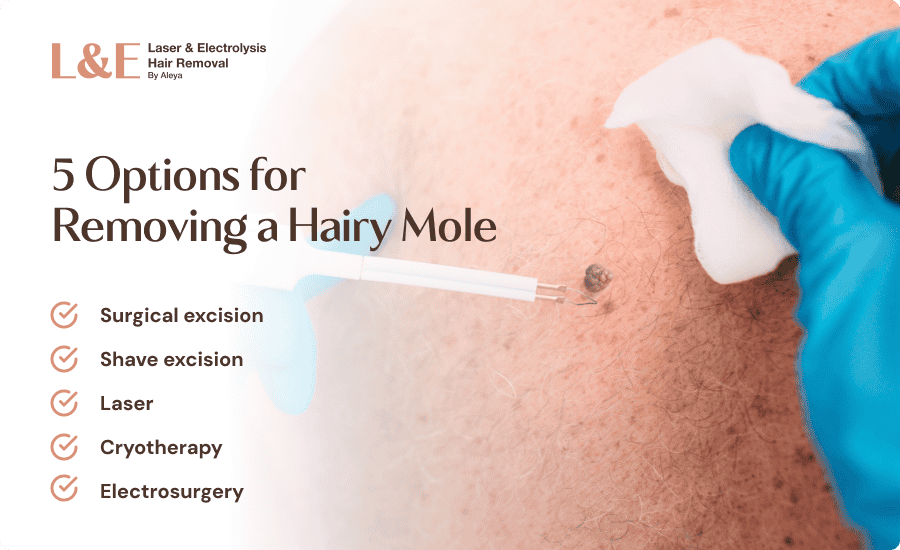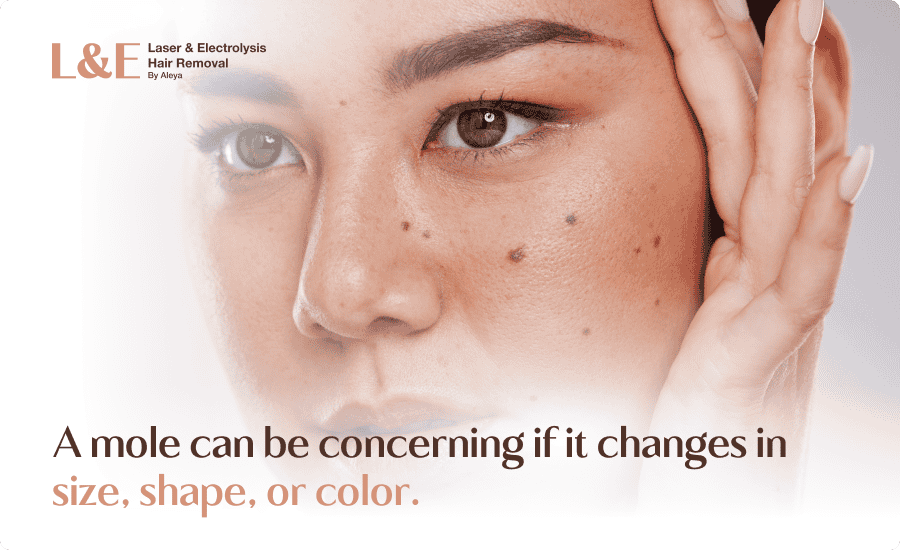Can You Perform Electrolysis on a Mole With Hair? [+ FAQs]
![Can You Perform Electrolysis on a Mole With Hair? [+ FAQs]](https://www.laserbyaleya.com/wp-content/uploads/2025/09/mole-with-hair-hero-image.png)
Can You Perform Electrolysis on a Mole With Hair? Key Takeaways
- In general, experts don’t recommend getting electrolysis on a hairy mole
- If you’re determined to remove hair from a mole, ensure a doctor examines it first. Once approved, ask for written permission to share with your electrologist.
- You’ll also need to sign a consent form before moving forward with treatment
The human body has about 5 million hair follicles, so it’s not unusual for a mole to form over one, sometimes even with a hair growing through it.
Before considering electrolysis for unwanted hair, it’s important to know that moles should never be treated directly with electricity.
Electrolysis can irritate the skin and, in rare cases, raise concerns about skin cancer.
That’s why a mole that grows hair should be checked by a doctor first and only treated once it’s been medically cleared.
Here’s what we’ll cover:
- Why electrolysis on a mole is risky
- What causes hair to grow from a mole
- Five medically approved ways to remove a hairy mole
- Safe electrolysis hair removal services at Laser by Aleya
Why Do Some Moles Grow Hair?
Moles don’t create hair on their own, but when they sit on top of an active follicle, hair can grow right through them.
5 Ways To Get Rid of a Hairy Mole
Hairy moles are usually harmless, but you may remove them for cosmetic reasons, irritation, or peace of mind, especially if your doctor needs to rule out skin cancer.
1. Surgical Excision
Surgical excision is the most common way to remove a mole.
The entire mole, along with a small area of surrounding skin, is cut out and the spot is stitched up.
Because it removes the hair follicle too, the hair usually doesn’t grow back.
It’s usually the go-to for larger moles or any that your doctor thinks should be checked more closely.
2. Shave Excision
Shave excision is a quick, low-impact option where the mole is shaved down to skin level, usually without the need for stitches.
Since it might leave the hair follicle behind, the hair could grow back.
3. Laser Mole Removal
Lasers can be a good option for smaller, flat moles, especially lighter-colored ones.
But here’s the catch: most lasers don’t go deep enough to fully destroy the hair follicle.
4. Cryotherapy
Cryotherapy involves freezing the mole with liquid nitrogen.
It destroys the mole tissue, but like laser treatment, it doesn’t always reach the hair follicle.
5. Electrosurgery
Electrosurgery utilizes an electric current to burn off the mole, often followed by a light scraping of the area, also known as curettage.
It removes the surface mole well, but might miss deeper follicles, which means the hair could still grow back.

How Does Electrolysis Hair Removal Work?
Electrolysis targets each hair follicle one at a time.
A super-fine probe is gently inserted into the follicle, and a tiny electric current destroys the root so it can’t regenerate hair.
Since electrolysis treats each hair individually, it can take time, but it’s also the only FDA-approved method for permanent hair removal that works on all skin tones and hair colors.
Thinking About Removing the Hair from a Mole at Home? Here’s Why You Shouldn’t
We get it. That one stubborn mole hair can drive you nuts!
It’s tempting to think, “I’ll just pluck it real quick,” or try an at-home electrolysis device, but even small DIY tweaks near a mole can cause irritation.
If a mole ever becomes concerning, messing with it could delay diagnosis.
That’s why we recommend getting a doctor’s ‘go-ahead’ before touching a mole, even for hair removal.
How Do Dermatologists Decide if a Mole Is Concerning?
Most moles are completely harmless and don’t need to be removed.
In fact, taking them off just for cosmetic reasons will leave a scar.
But if a mole looks suspicious, whether it’s changing in size, shape, or color, your dermatologist might recommend a biopsy.
In most cases, you’ll get results within a week.
If the biopsy shows the mole is cancerous, your dermatologist will remove the entire thing to make sure no cancerous cells are left behind.

What Happens if You Undergo Electrolysis on a Hairy Mole Without Medical Clearance?
Electrolysis hair removal on a mole without a doctor’s approval might seem harmless, but it can lead to risks, including:
1. Irritated Mole
Moles are often more sensitive than the skin around them.
Using electrical current on one might cause redness, swelling, or irritation that takes longer to heal.
In some cases, it might even cause scabbing or scarring.
2. Delayed Diagnosis of Skin Cancer
If a mole is changing in shape, size, or color, it could be a red flag.
Getting electrolysis before a doctor has a chance to examine it might delay a diagnosis.
And when it comes to skin cancer, early detection is everything.
Considering Electrolysis for a Hair Mole at Laser by Aleya?
If you’re thinking about electrolysis to remove hair from or around a mole, you’re in good hands at Laser by Aleya.
Aleya provides safe and expert care in a clean, comfortable space, but she’ll always put your health first.
We require medical clearance from your doctor before treating any area that includes a mole.
This simple precaution ensures your skin is safe to work on and helps prevent unnecessary risk.
Once you’re cleared, electrolysis is a highly precise, permanent hair removal method that works beautifully on facial areas, including around moles, leaving your skin smoother for the long haul.
Whether you’re managing stubborn chin hairs or fine fuzz on the cheeks, Aleya’s effective treatments are tailored to your skin type, hair color, and comfort level.
Can You Perform Electrolysis on a Mole With Hair? FAQs
Can electrolysis be done near a mole?
Yes, electrolysis can safely be performed near a mole, if the mole itself isn’t being treated.
Why is the hair on my mole darker?
Moles have pigment-producing cells, which can make any hair growing from them look darker and thicker than the rest.
And if you’ve been plucking it, that can actually make the hair come back even coarser over time.
Are hairy moles cancerous?
No, having hair on a mole doesn’t mean it’s cancerous.
If you’re concerned about your hairy mole, it’s a good idea to have a dermatologist take a look.
What are the signs of a cancerous mole?
A common early sign of melanoma is a mole that changes in size, shape, or color.
Moles with irregular borders or more than one color are especially important to watch, as these can be warning signs of skin cancer.
Can I apply hair removal cream on a mole?
No, it’s best to avoid applying hair removal cream directly on a mole.
These products aren’t meant for moles, irritated skin, or areas with cuts, swelling, or sunburn.
Can electrolysis remove hair growing near a mole?
Absolutely. Electrolysis can safely target hair around a mole, as long as the mole itself isn’t being treated.
It’s a great option for those little hairs nearby, especially when done by a trained professional who knows how to work with delicate areas.
Is it okay to pluck hair from a mole?
It might feel like a quick fix, but plucking can actually irritate the mole or cause redness and inflammation.
Over time, it might even lead to scarring or make the hair grow back thicker.
It’s always better to check with a professional before touching the area.
Do I need a note for every mole near the treatment area?
You don’t need clearance for every mole, just the ones that are in or very close to the area being treated.
If the hair is growing directly from a mole, Aleya will ask for a note from your doctor to make sure it’s safe to treat.
Can electrolysis make a mole dangerous?
No, electrolysis doesn’t make moles turn cancerous.
The main concern is that treating a mole without a doctor’s go signal could irritate the skin or delay spotting a change.
Is it normal to have a single mole with hair?
Yes, it’s normal. If a mole happens to form over a follicle, a lone strand might poke through.
Can laser and electrolysis hair removal be done at the same time?
No, laser and electrolysis shouldn’t be done on the same area at the same time.
We recommend completing your laser hair removal treatments first, then using electrolysis to clean up any remaining hair.


